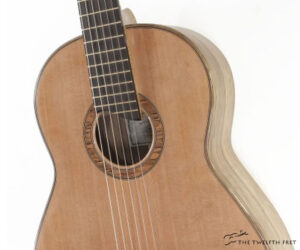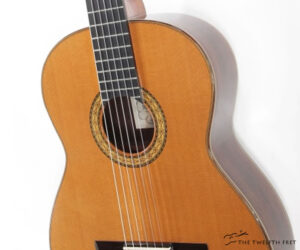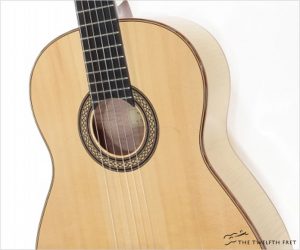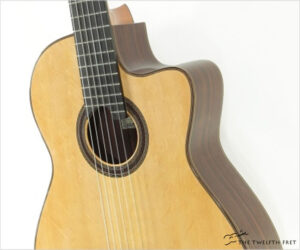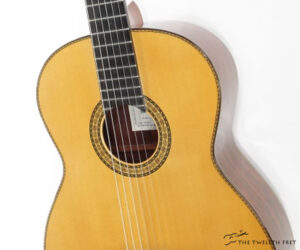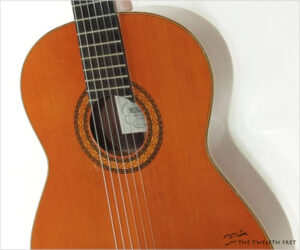Seen here is a new Sergei de Jonge Classical Guitar with an elevated fingerboard, pairing a Cedar top with Black Limba for the sides, back and neck. The bracing is Spruce, the body blocks and linings are Mahogany. The bridge is Indian Rosewood and the fingerboard is Ebony. As is the case for most of de Jonge’s guitars, the finish is a hand-applied French Polish.
Nylon
The M. Sakurai No.8 Cedar Top Classical guitars, indeed the entire line of Masaki Sakurai models, are under-appreciated gems. The set of guitars with labels reading ‘M. Sakurai Supervised by M. Kohno’ are from the period where Masaki Sakurai was still learning the craft from his uncle, Masaru Kohno.
This instrument has sold
MORE →Here is another fine and unusual guitar, a Kolya Panhuyzen Maple Body Classical model built in Toronto, Canada during 1987. Kolya Panhuyzen grew up around classical guitar construction and worked with his uncle, Edgar Monch, in both Germany and Toronto.
This instrument has sold
MORE →This Kenny Hill Curva Negra Crossover was built in Hill’s Felton, California workshop during 2005 and features a Hauser-influenced cutaway body. The guitar has a Bearclaw-figured Spruce top paired with Indian Rosewood for sides, back headplate and bridge.
This instrument has sold
MORE →This is something special – a Masaru Kohno Special Brazilian Rosewood guitar, at or near the top of his line. The ‘Special’ model was originally named the ‘No.50’ and its bridge has a distinctive forward sweep. Signed by M. Kohno and dated to 1990, this well preserved professional grade instrument features a seven-fan European Spruce top paired with Brazilian Rosewood for the sides, back, heel cap, head plate and bridge.
This instrument has sold
MORE →Masaki Sakurai is the nephew of the late, renowned Japanese luthier Masaru Kohno, and as customary, is the heir to the Kohno shop. The M. Sakurai No.5 was one of his early instruments designed and built during his apprenticeship beginning in 1976. The M. Sakurai No.5 classical guitar is based closely on Kohno designs, and construction of these early models would have been closely supervised by Kohno himself.
This instrument has sold
MORE →